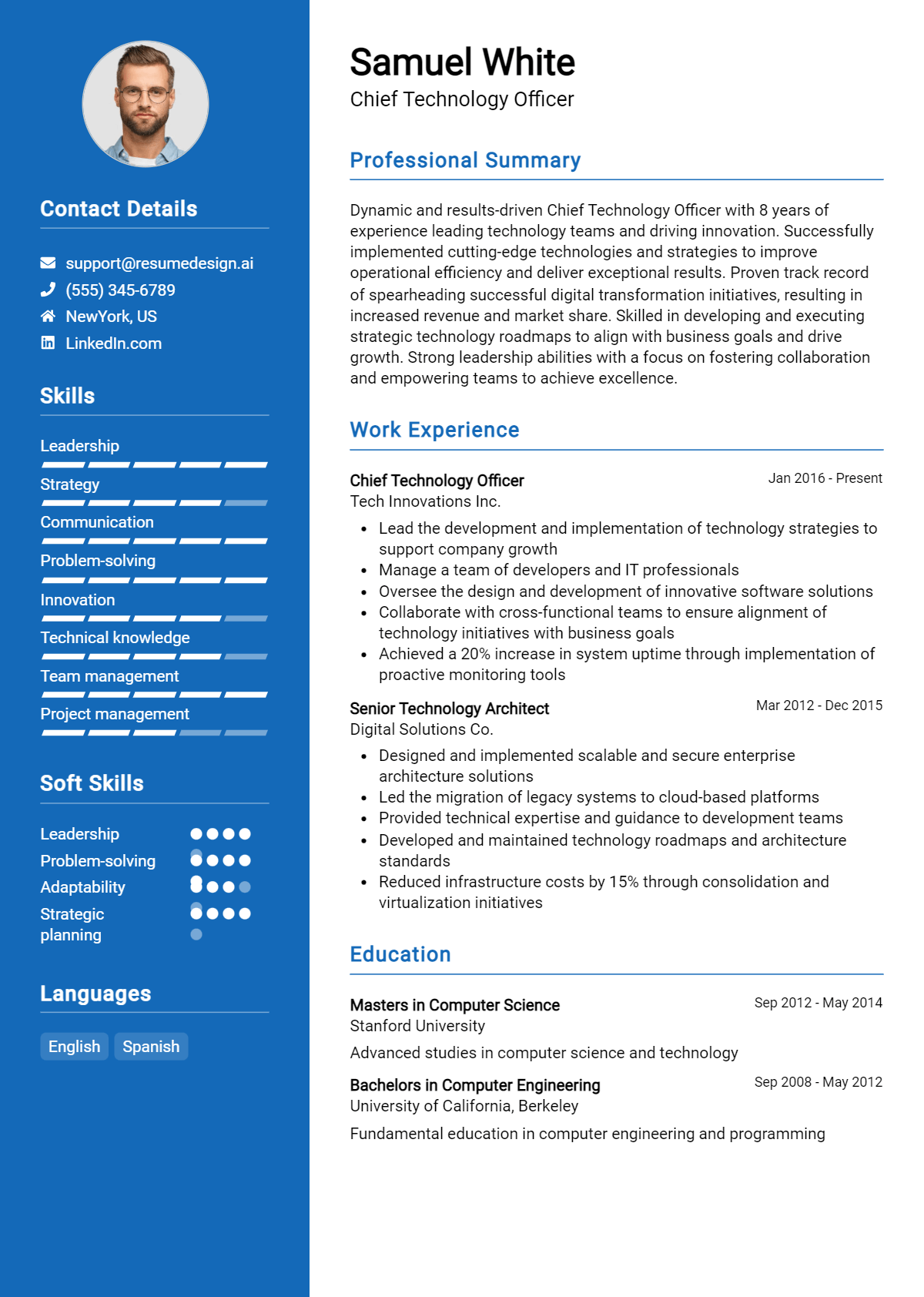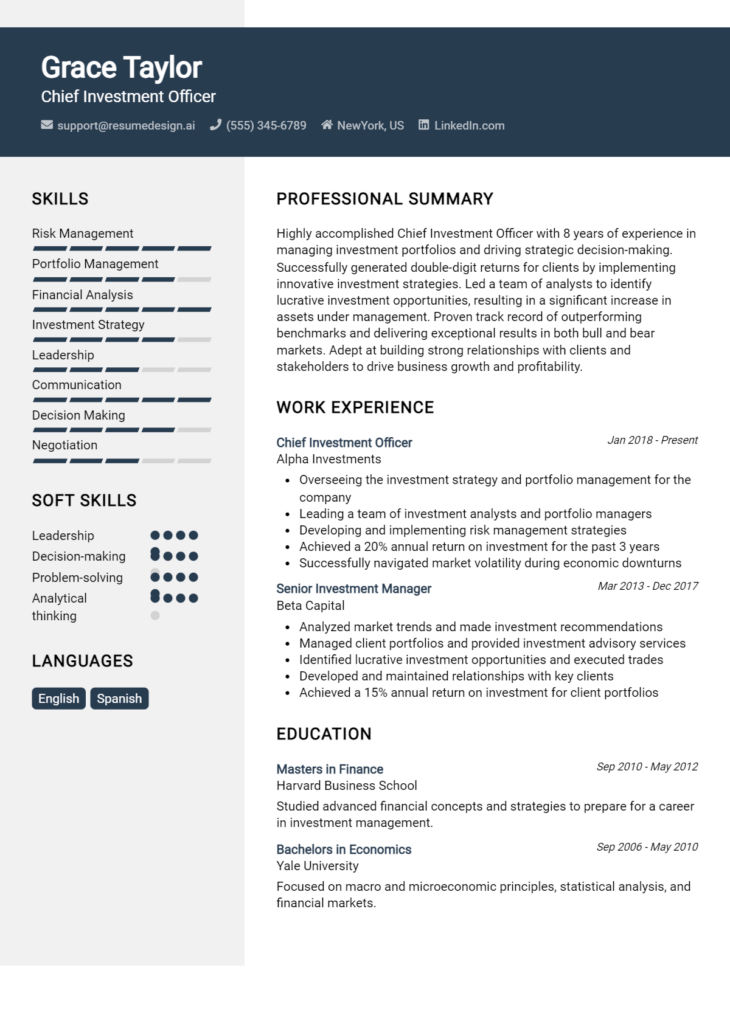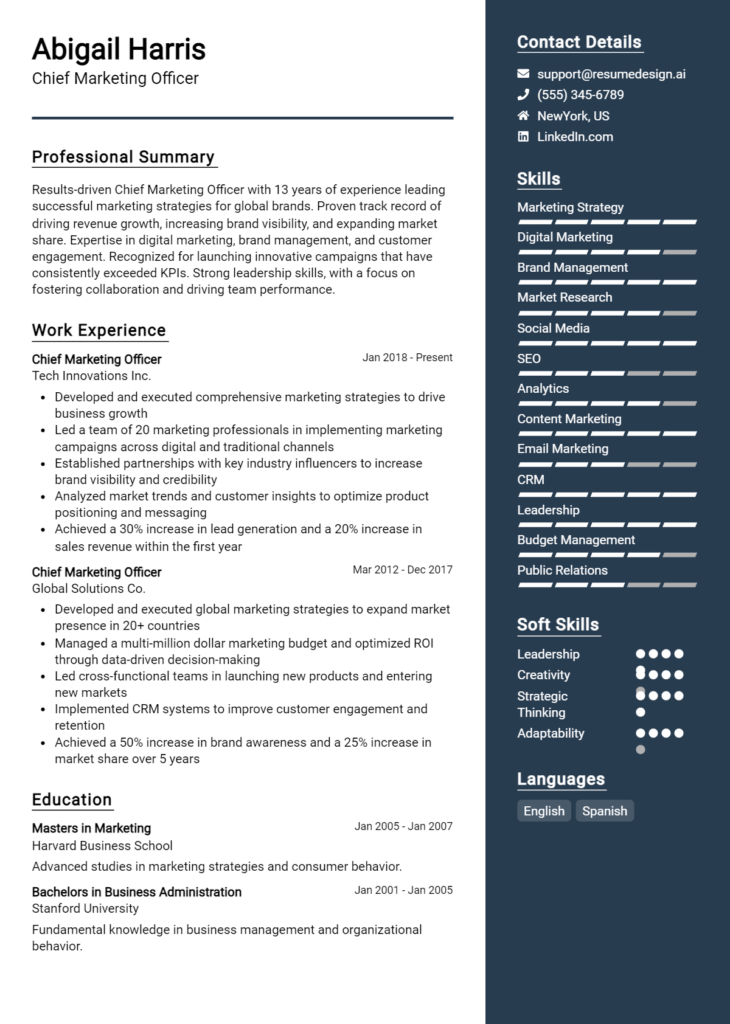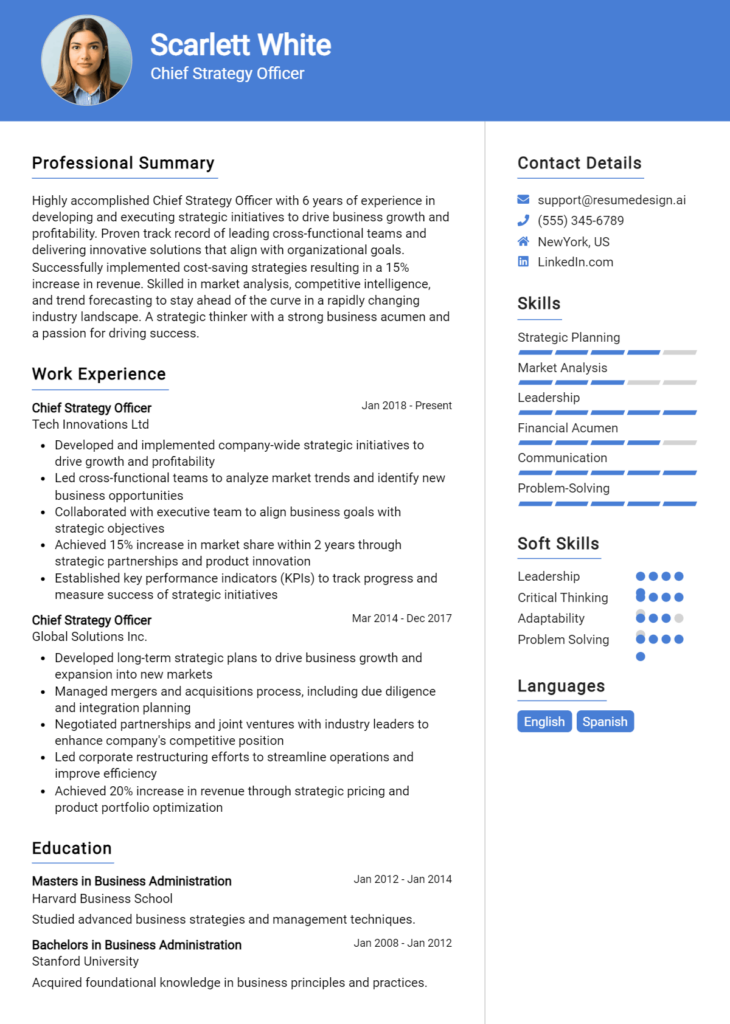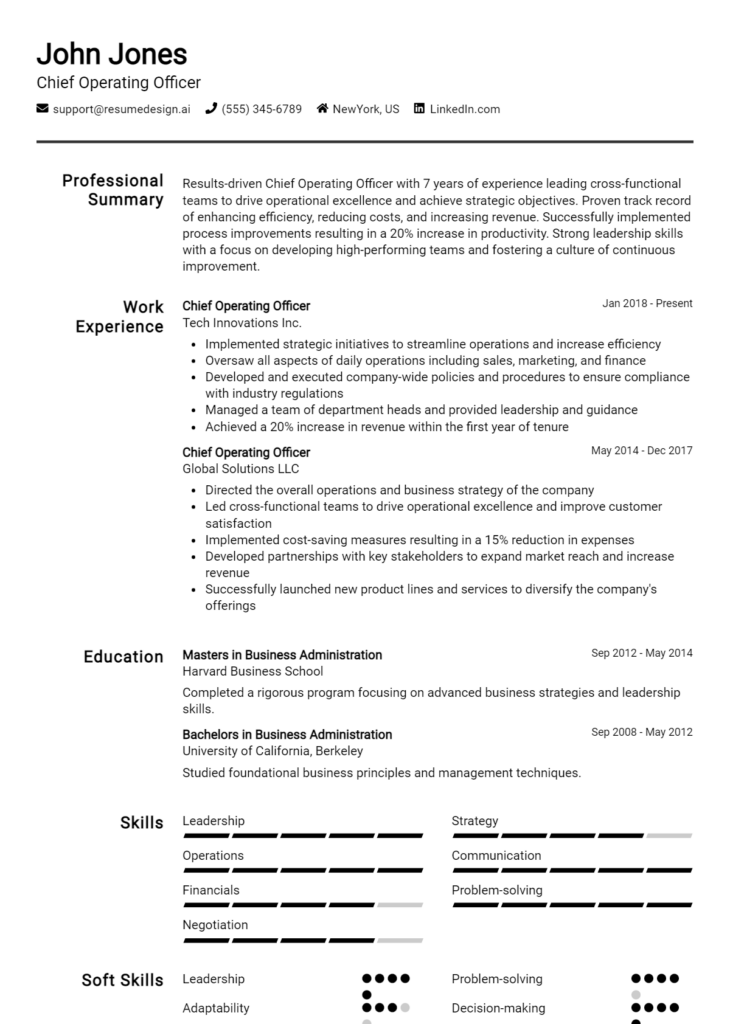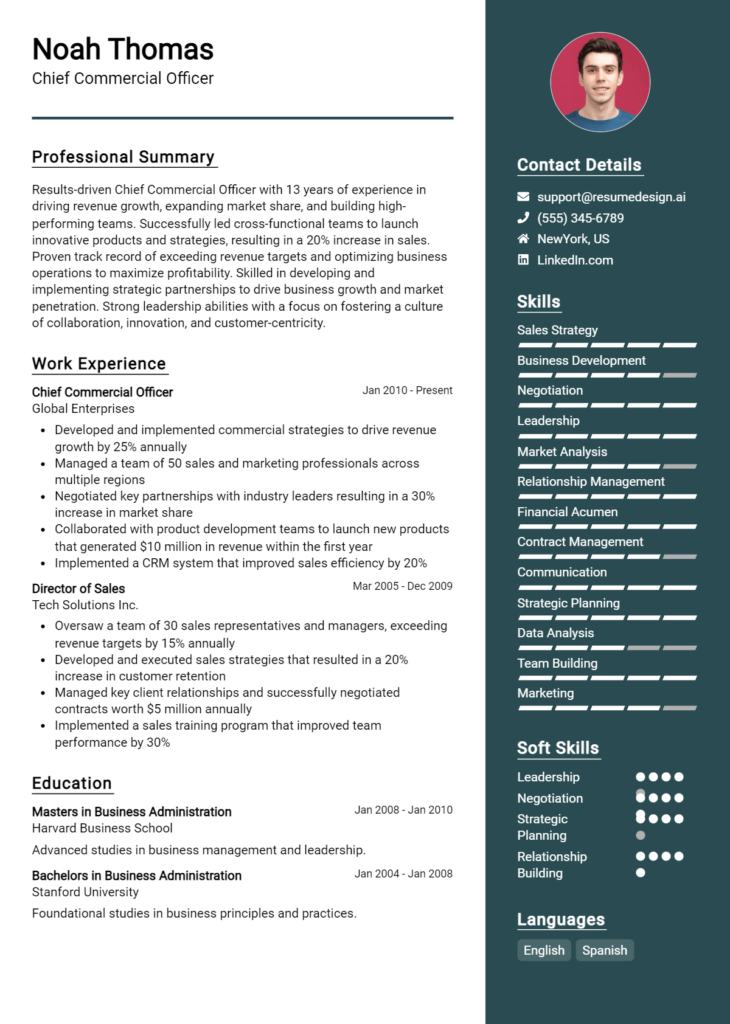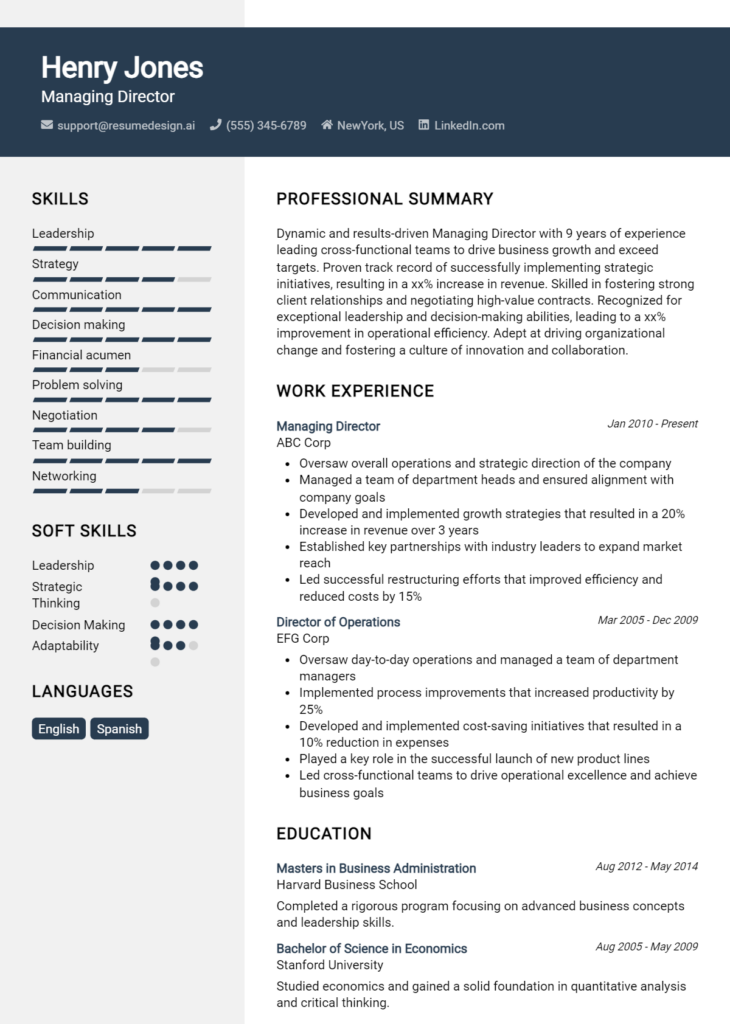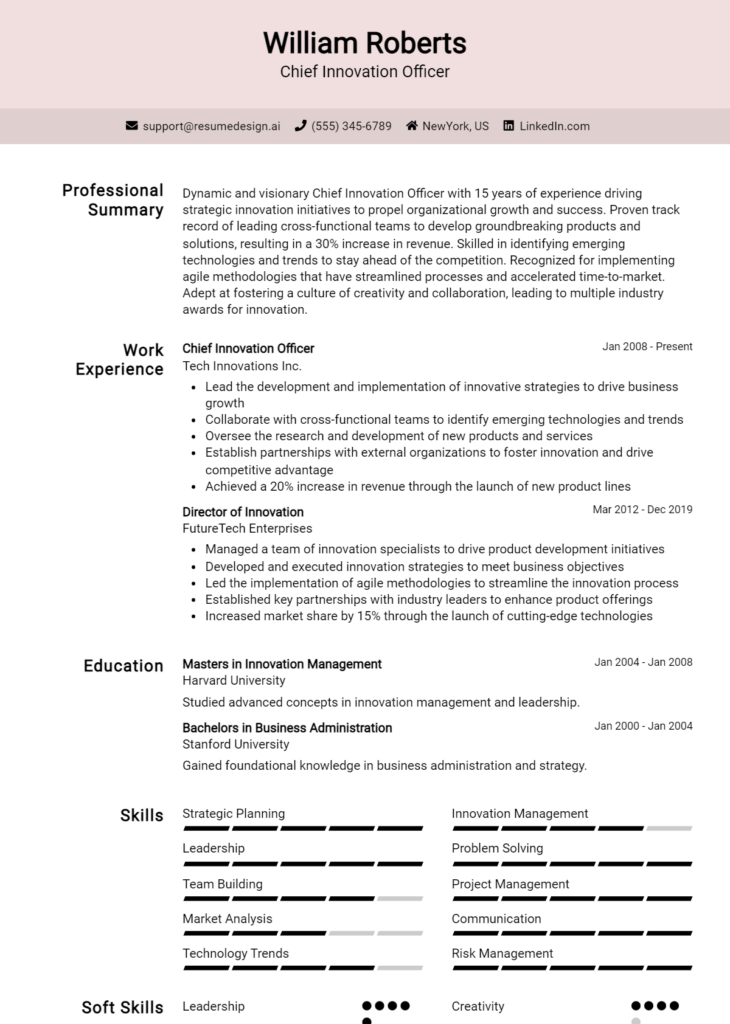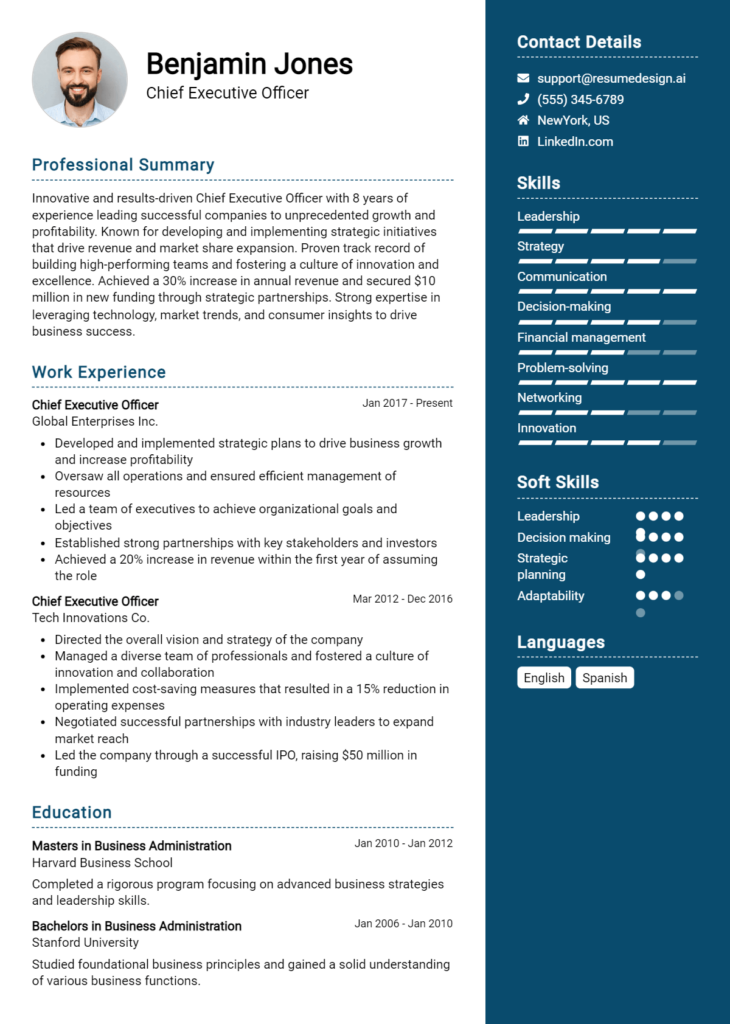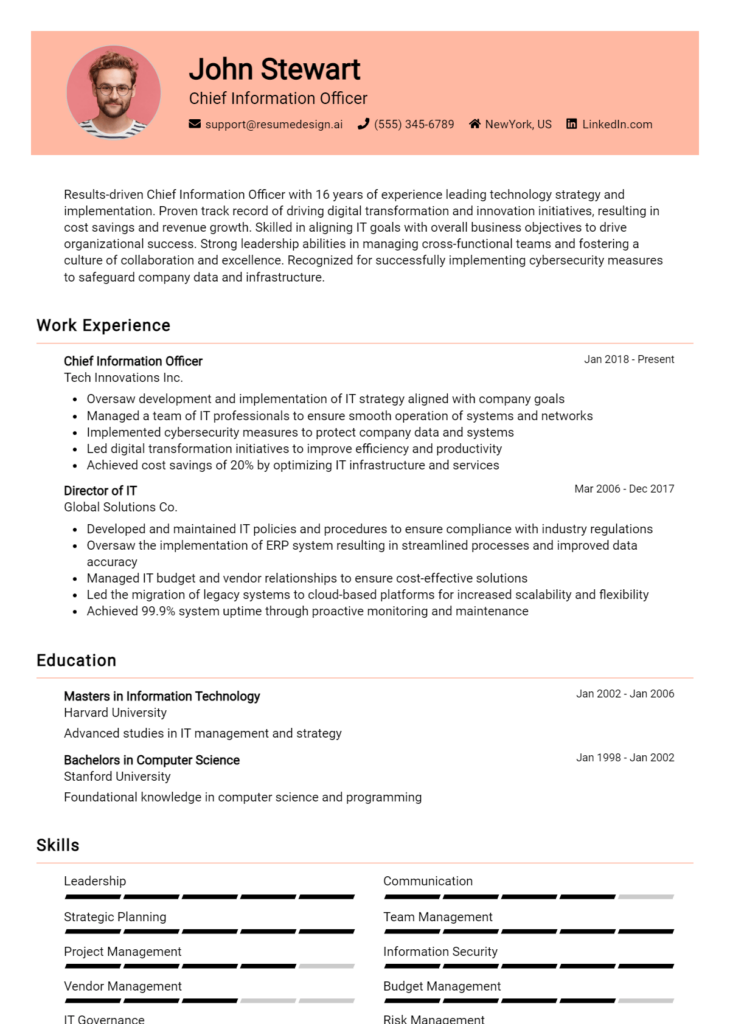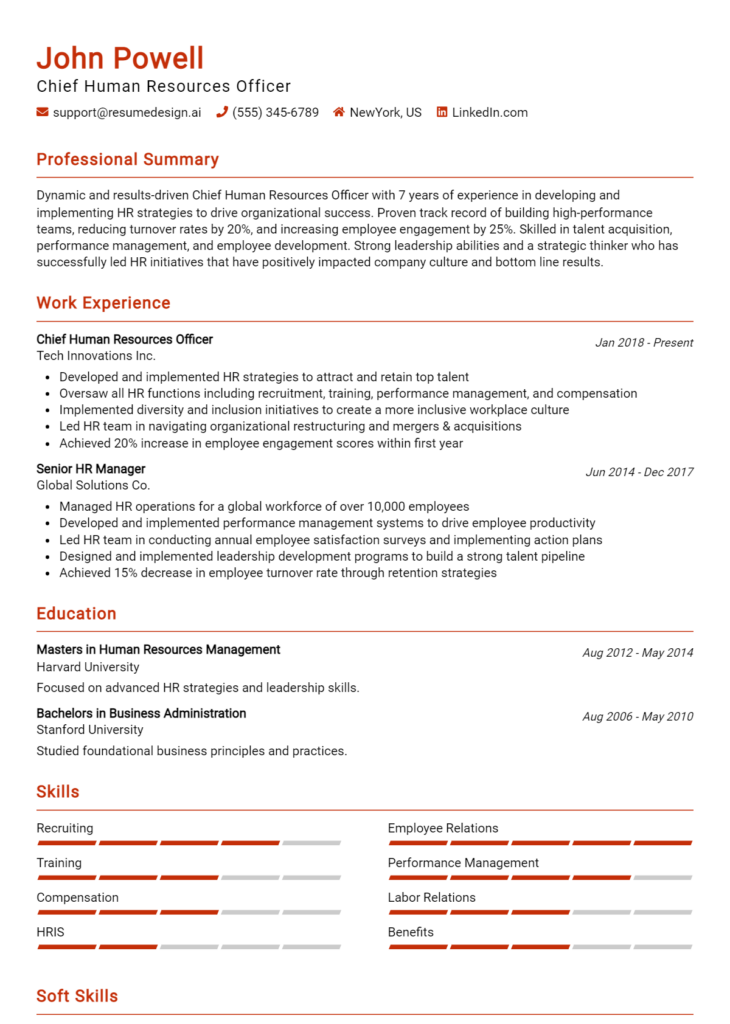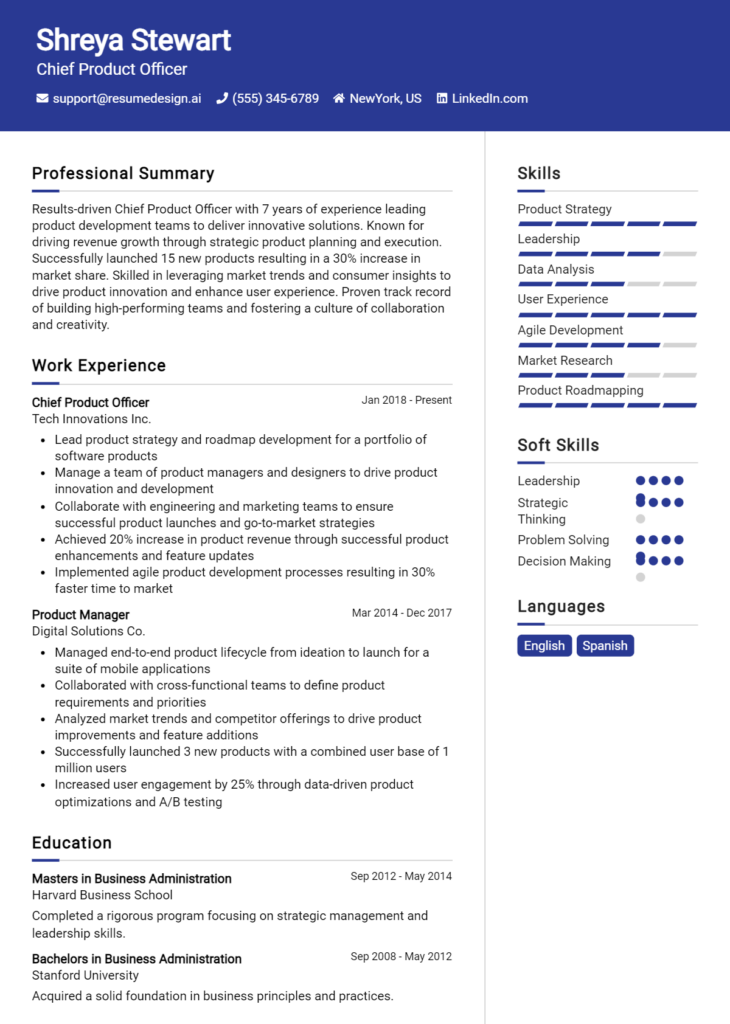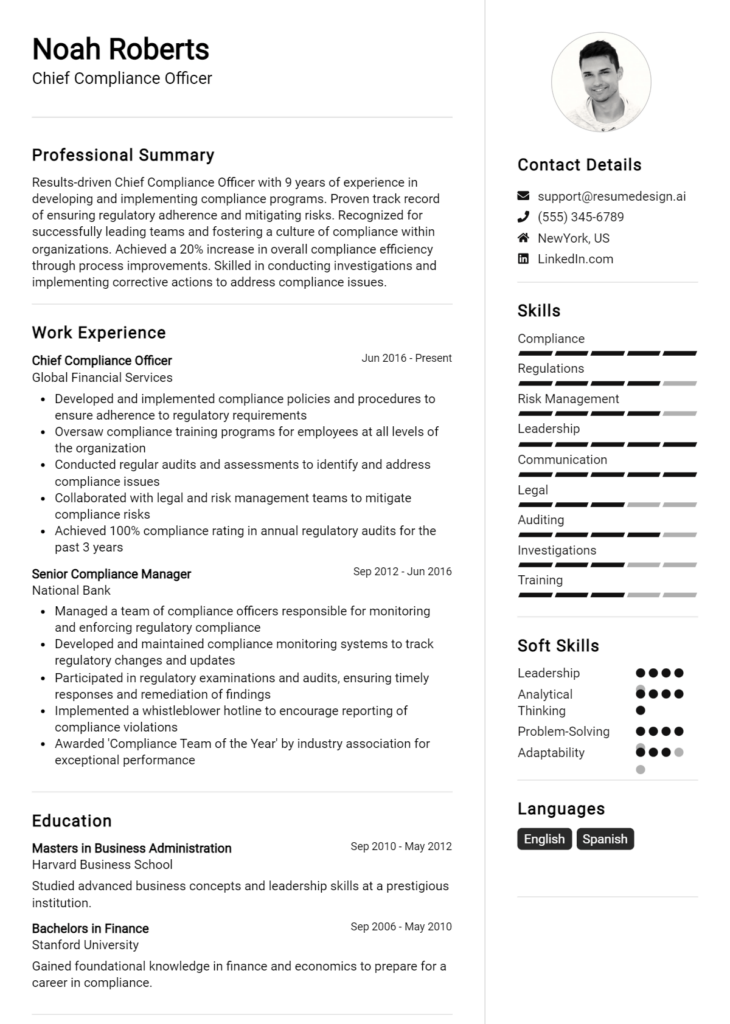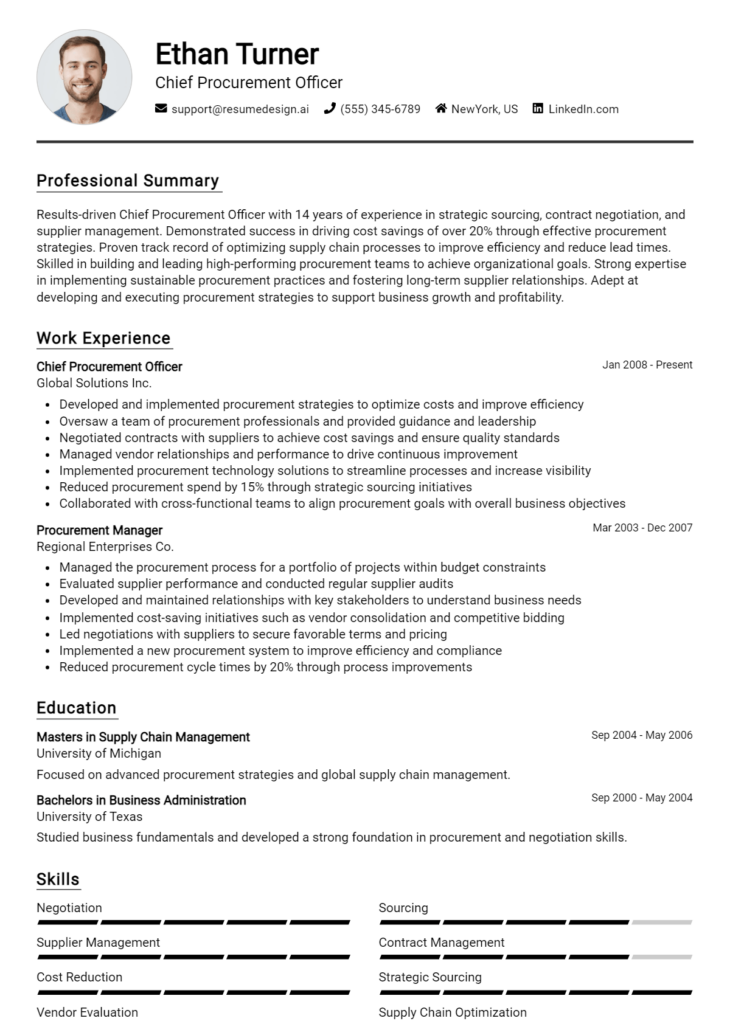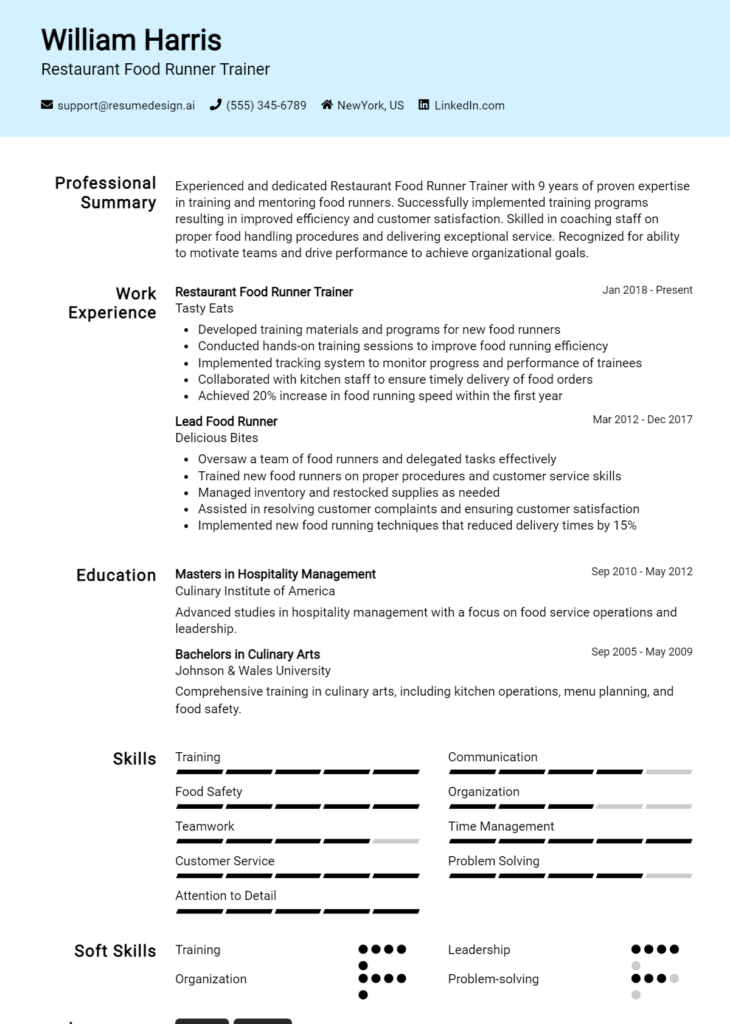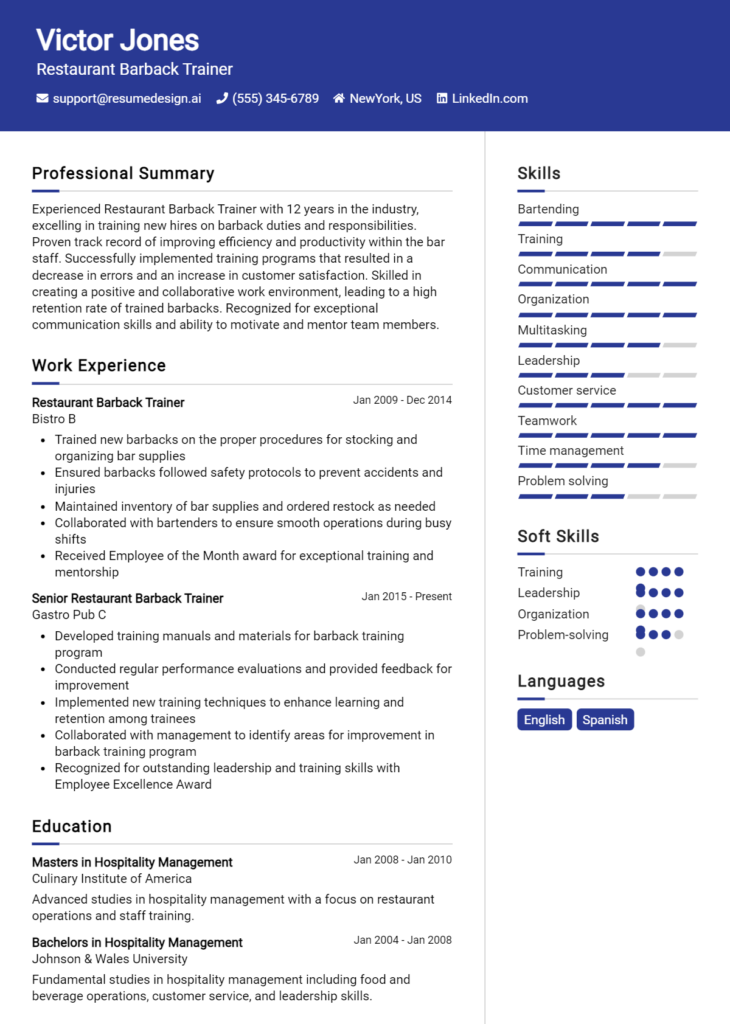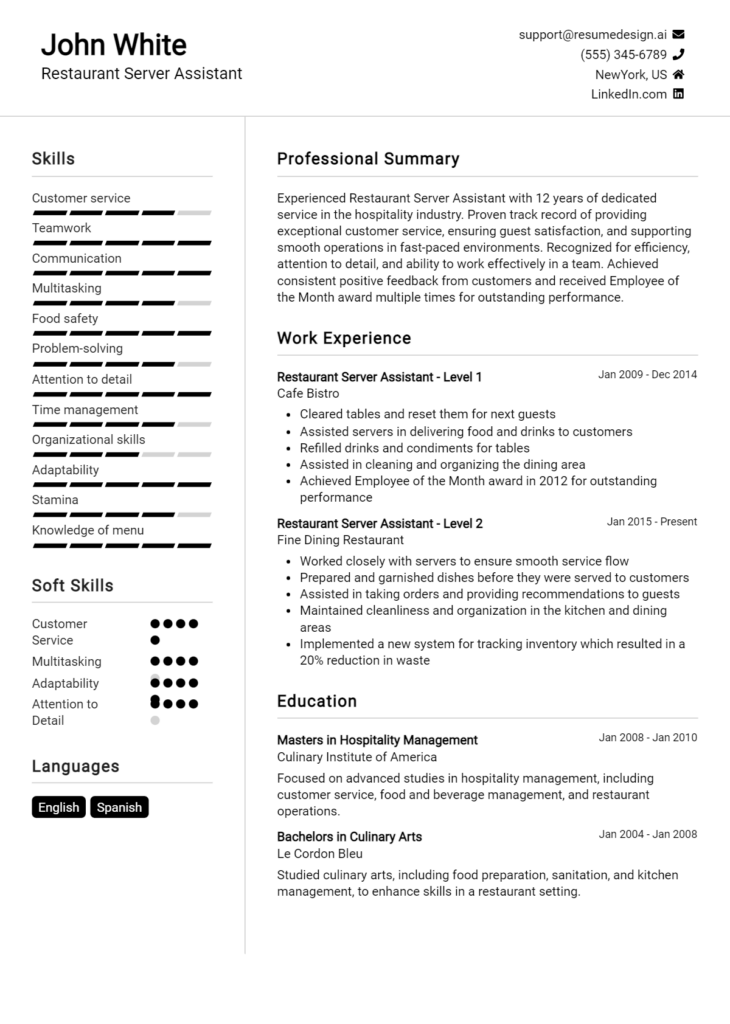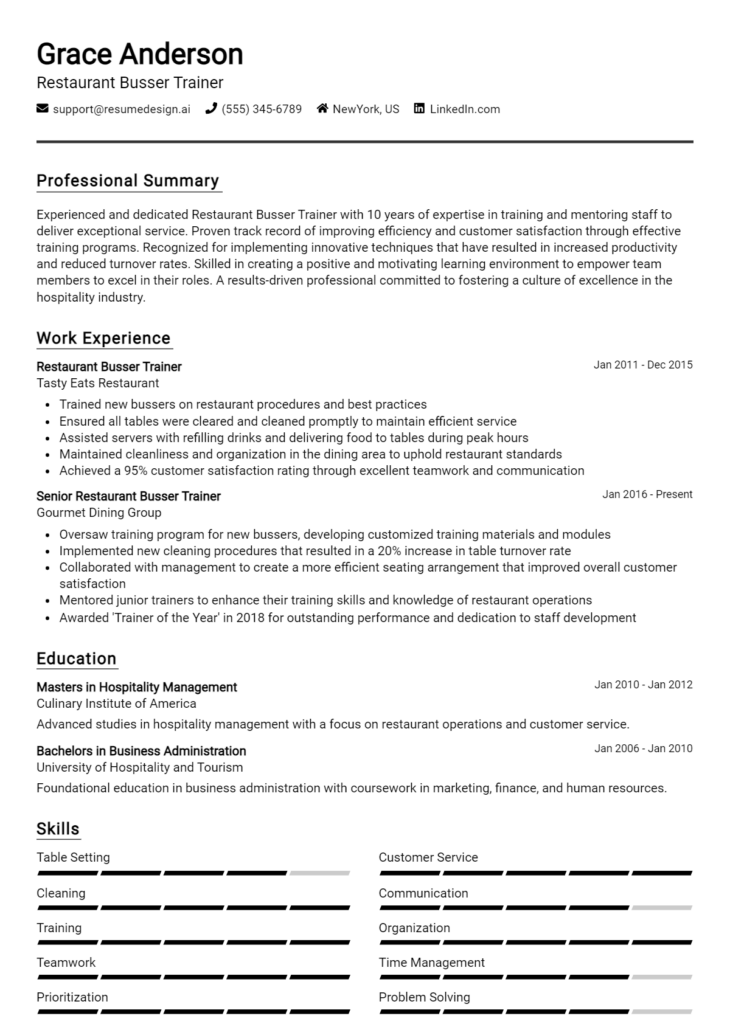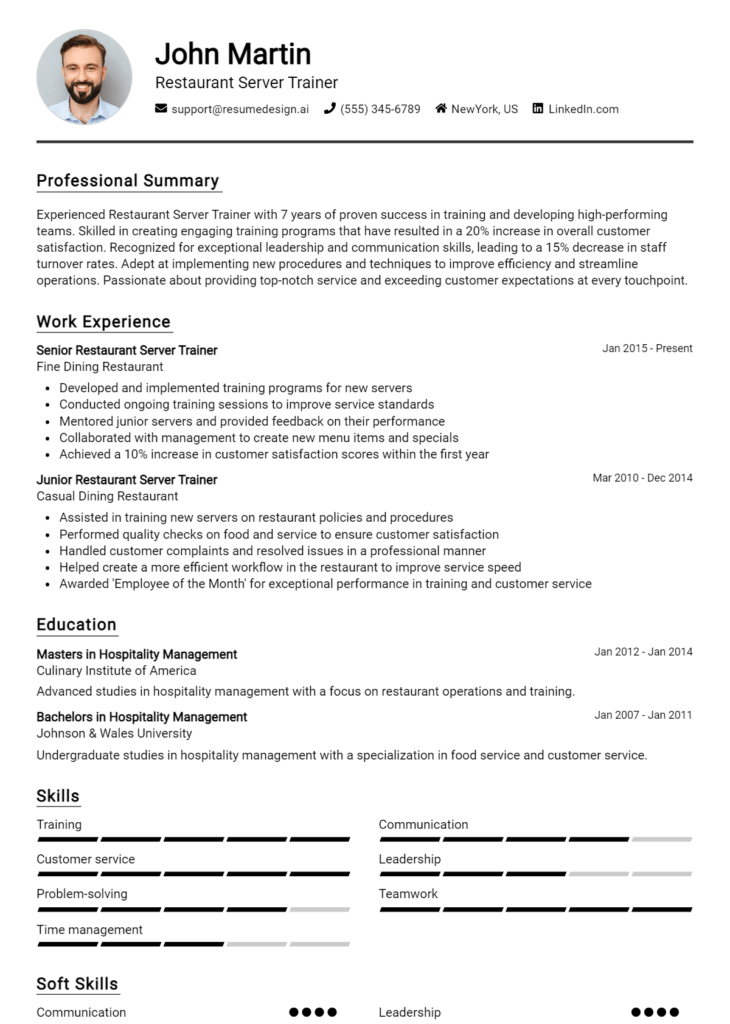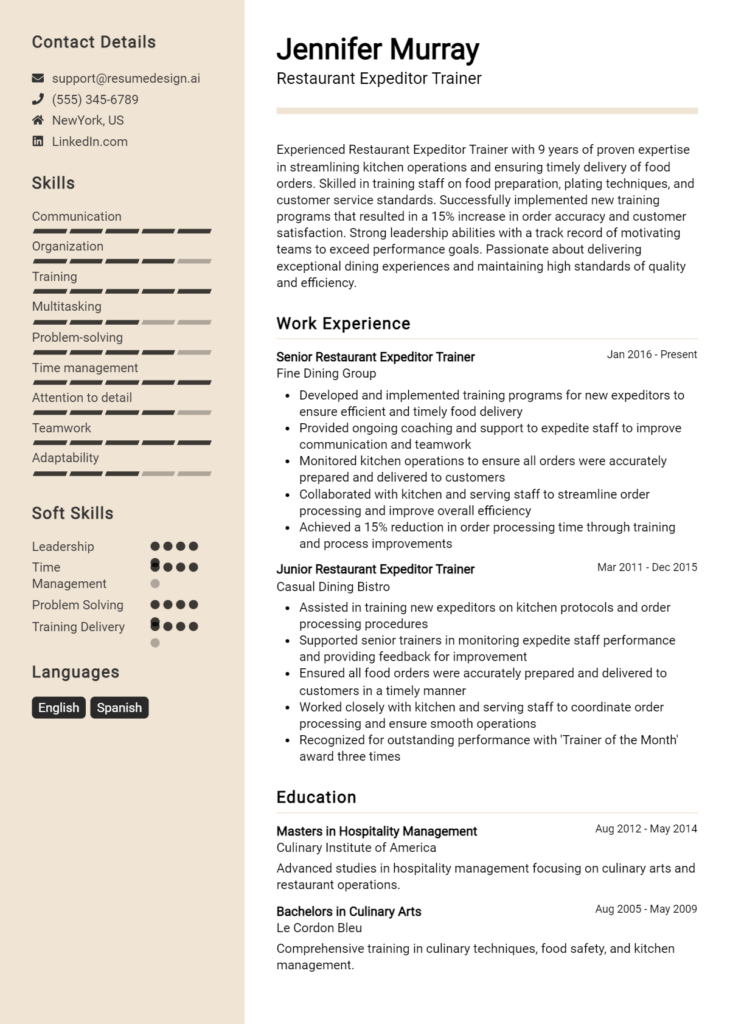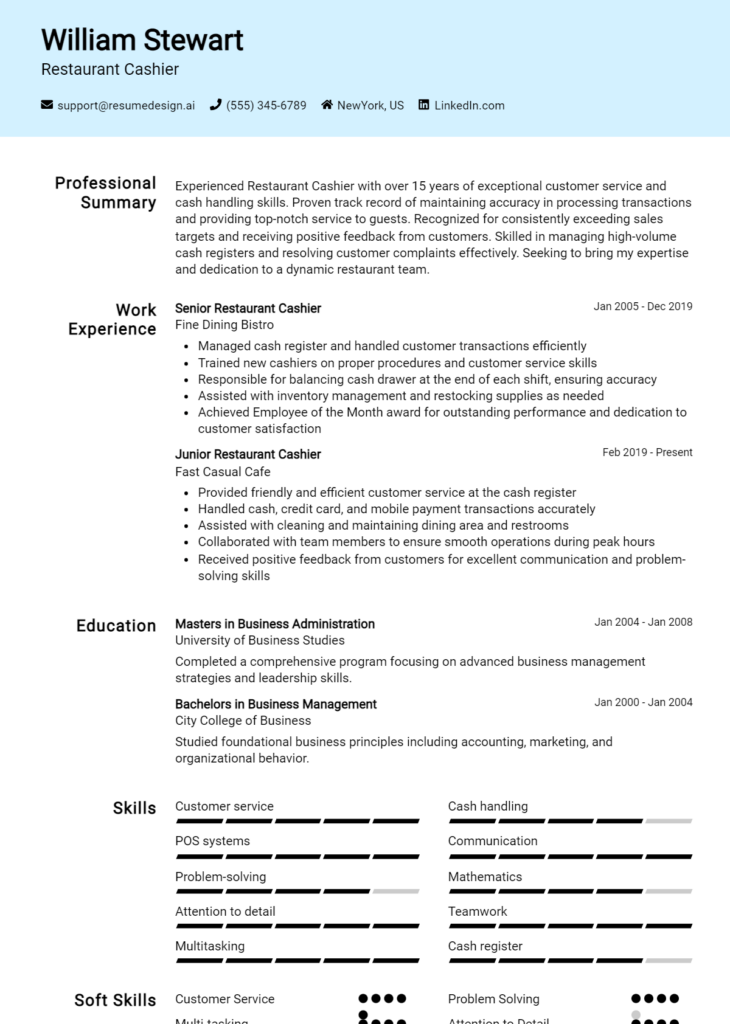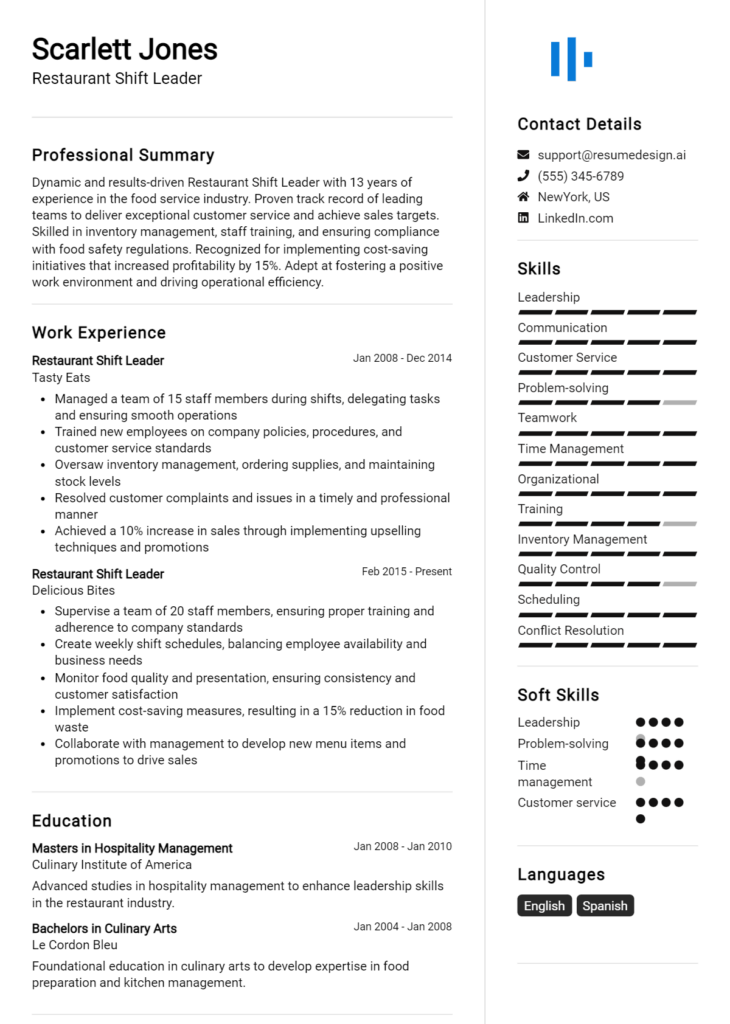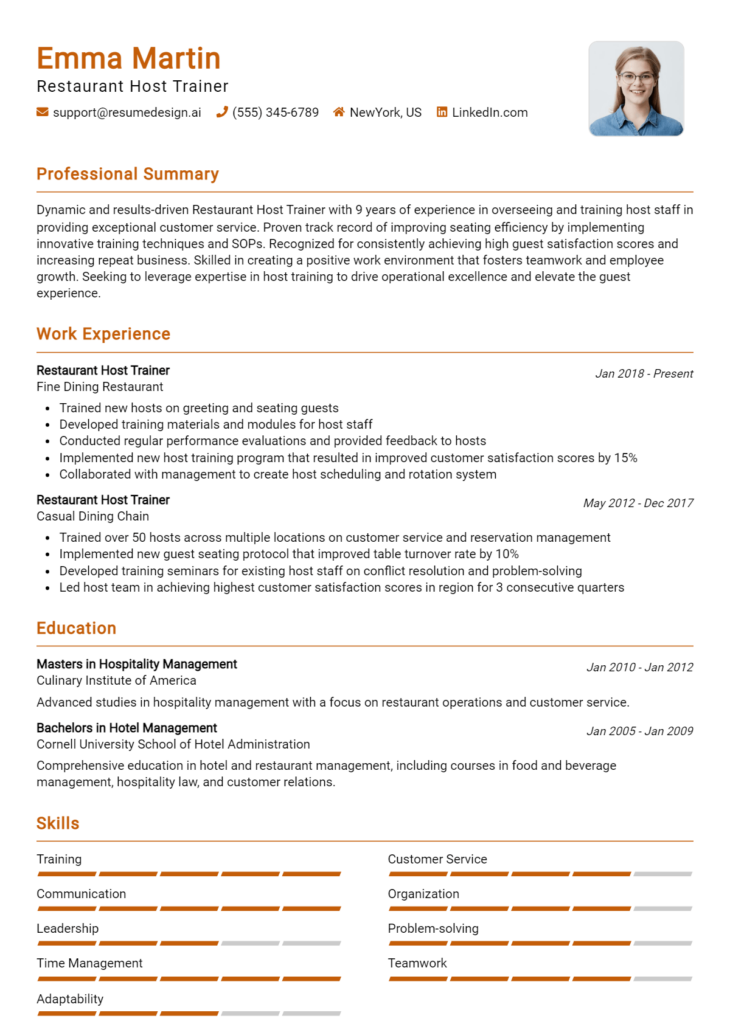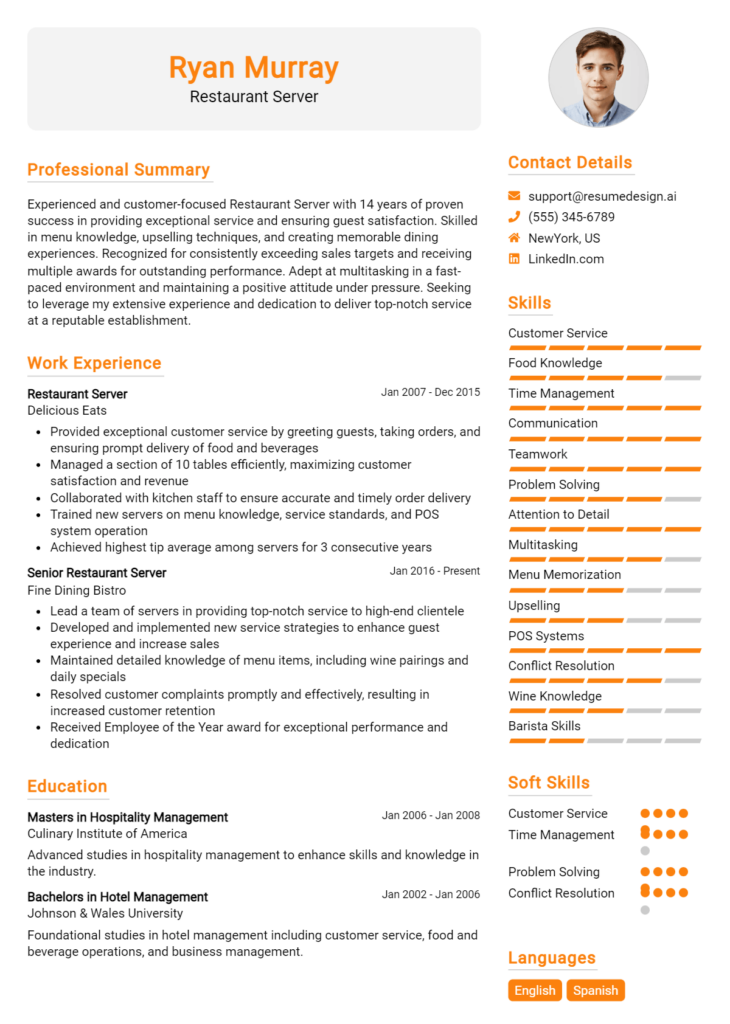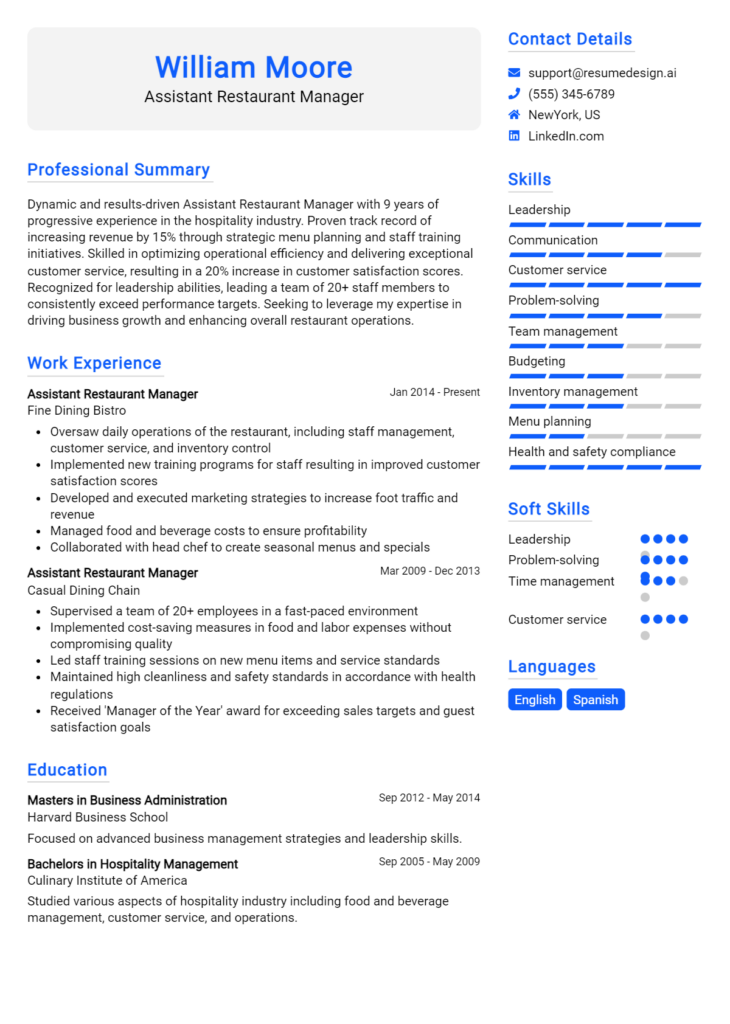Chief Technology Officer Core Responsibilities
The Chief Technology Officer (CTO) plays a vital role in aligning technology strategy with business goals, acting as a bridge between various departments such as IT, operations, and product development. Key responsibilities include overseeing technology development, implementing innovative solutions, and ensuring operational efficiency. Essential skills encompass technical expertise, strategic planning, and problem-solving capabilities, which are crucial for driving organizational success. A well-structured resume can effectively highlight these qualifications, demonstrating how a CTO can contribute to achieving the company’s objectives.
Common Responsibilities Listed on Chief Technology Officer Resume
- Developing and implementing technology strategies aligned with business objectives.
- Overseeing the technology development lifecycle and managing IT infrastructure.
- Collaborating with cross-functional teams to drive innovation and efficiency.
- Evaluating and integrating new technologies to enhance operational capabilities.
- Leading and mentoring IT staff to foster professional growth and expertise.
- Ensuring data security and compliance with industry regulations.
- Managing budgets and resources for technology projects.
- Communicating technology vision and strategy to stakeholders and executives.
- Identifying industry trends and assessing their potential impact on the organization.
- Driving digital transformation initiatives across the business.
High-Level Resume Tips for Chief Technology Officer Professionals
In today's competitive job market, a well-crafted resume is essential for Chief Technology Officer (CTO) professionals looking to make a strong impression on potential employers. Your resume serves as the first point of contact with hiring managers, and it needs to effectively reflect not only your technical skills but also your significant achievements and leadership capabilities. A compelling resume can set you apart from other candidates and open doors to exciting opportunities. This guide will provide practical and actionable resume tips specifically tailored for Chief Technology Officer professionals, ensuring you present yourself as the ideal candidate in this pivotal role.
Top Resume Tips for Chief Technology Officer Professionals
- Tailor your resume to the specific job description, highlighting the skills and experiences that align with the company's needs.
- Showcase relevant experience by emphasizing previous roles where you led technology initiatives or teams.
- Quantify your achievements with metrics, such as revenue growth, cost savings, or project completion rates, to demonstrate your impact.
- Highlight industry-specific skills, such as proficiency in emerging technologies, cybersecurity measures, or software development methodologies.
- Utilize a clear and professional format that enhances readability and emphasizes key sections like your summary and skills.
- Include a strong professional summary at the top of your resume that captures your career goals and key qualifications.
- Incorporate keywords related to technology leadership and management to pass through Applicant Tracking Systems (ATS).
- Demonstrate your strategic vision by mentioning successful technology roadmaps or digital transformation initiatives you have led.
- Keep your resume concise, ideally one to two pages, focusing on the most relevant information to the position.
- Include professional development, such as certifications or ongoing education, to showcase your commitment to staying current in the technology field.
By implementing these tips, you can significantly enhance your resume and increase your chances of landing a job in the Chief Technology Officer field. A well-structured and tailored resume not only highlights your qualifications but also showcases your leadership potential, making you a more attractive candidate to employers seeking top-tier technology executives.
Why Resume Headlines & Titles are Important for Chief Technology Officer
In the competitive landscape of executive recruitment, particularly for roles like Chief Technology Officer (CTO), the significance of resume headlines and titles cannot be overstated. A strong headline or title serves as a powerful first impression, immediately capturing the attention of hiring managers while succinctly summarizing a candidate's key qualifications and achievements. It should be concise, relevant, and tailored to the specific role being applied for, effectively setting the tone for the rest of the resume. A well-crafted headline can distinguish a candidate in a crowded field, leading to increased interest and opportunities for interviews.
Best Practices for Crafting Resume Headlines for Chief Technology Officer
- Keep it concise – Aim for one impactful phrase.
- Make it role-specific – Clearly indicate your position as a CTO.
- Highlight key strengths – Include your core competencies relevant to the role.
- Use action-oriented language – Utilize dynamic and engaging verbs.
- Incorporate industry keywords – Align your headline with common terms in the tech industry.
- Focus on unique selling points – Mention any standout achievements or experiences.
- Reflect your career stage – Ensure your title matches your level of experience.
- Avoid clichés – Steer clear of generic phrases that lack specificity.
Example Resume Headlines for Chief Technology Officer
Strong Resume Headlines
Innovative CTO with 15+ Years Leading Tech Transformation and Digital Strategy
Results-Driven Chief Technology Officer Specializing in Cloud Solutions and Cybersecurity
Strategic Technology Leader with Proven Track Record in Scaling Startups and Driving Growth
Visionary CTO Focused on Leveraging AI and Machine Learning for Business Optimization
Weak Resume Headlines
Experienced Professional Looking for Opportunities
Technology Expert Seeking a CTO Position
Chief Technology Officer with Various Skills
The strong headlines are effective because they are specific, incorporating vital information about the candidate's experience and unique skills. They convey a clear message about what the candidate brings to the table, which resonates with hiring managers looking for particular qualifications. On the other hand, the weak headlines fall flat due to their vagueness and lack of detail, failing to communicate any compelling reason for consideration. In a competitive job market, specificity and impact are crucial for standing out and making a memorable impression.
Writing an Exceptional Chief Technology Officer Resume Summary
A well-crafted resume summary is crucial for a Chief Technology Officer (CTO) as it serves as the first impression for hiring managers. In a highly competitive job market, a strong summary quickly captures attention by succinctly showcasing key skills, relevant experience, and notable accomplishments that align with the job role. This brief yet impactful section should be tailored to each specific position, ensuring that it reflects the unique qualifications and vision of the candidate, ultimately setting the stage for further engagement in the hiring process.
Best Practices for Writing a Chief Technology Officer Resume Summary
- Quantify Achievements: Use metrics and specific numbers to illustrate your impact, such as revenue growth or cost savings.
- Focus on Core Skills: Highlight technical proficiencies, leadership skills, and strategic thinking abilities relevant to the CTO role.
- Tailor for the Job Description: Customize the summary to reflect the requirements and responsibilities outlined in the job posting.
- Be Concise: Keep the summary brief—ideally 3-5 sentences that encapsulate your professional identity.
- Showcase Leadership Experience: Emphasize your experience in leading teams, driving innovation, and managing technology initiatives.
- Highlight Industry Knowledge: Mention any specific industry experience that relates to the position you are applying for.
- Utilize Action Words: Start sentences with dynamic verbs that convey your proactive approach and accomplishments.
- Convey Vision: Articulate your strategic vision for technology within the organization to demonstrate forward-thinking leadership.
Example Chief Technology Officer Resume Summaries
Strong Resume Summaries
Dynamic Chief Technology Officer with over 15 years of experience leading technology transformations that resulted in a 30% increase in operational efficiency and a 25% reduction in costs. Proven track record in developing innovative software solutions that drive business growth and enhance customer satisfaction.
Results-oriented CTO with a decade of experience in the fintech sector, spearheading the development of a mobile banking platform that attracted over 500,000 users in the first year, generating $2M in revenue. Expert in aligning technology strategies with business objectives to foster sustainable growth.
Innovative technology leader with extensive experience in cloud computing and cybersecurity. Successfully implemented a cloud migration strategy that decreased IT overhead by 40% while improving system reliability and security posture across the organization.
Weak Resume Summaries
Experienced technology executive with a broad range of skills. I have worked in various companies and managed teams.
Chief Technology Officer with some experience in leading projects and teams in technology settings. Looking for a new opportunity to grow.
The examples above illustrate the stark difference between strong and weak resume summaries. Strong summaries are characterized by their specificity, quantifiable outcomes, and direct relevance to the CTO role, showcasing a clear understanding of the responsibilities expected in the position. In contrast, weak summaries lack detail and do not provide measurable achievements, making them less compelling to hiring managers who seek candidates with proven expertise and a track record of success.
Work Experience Section for Chief Technology Officer Resume
The work experience section is a critical component of a Chief Technology Officer (CTO) resume, as it effectively showcases a candidate's technical skills, leadership capabilities, and their capacity to deliver high-quality products. This section provides valuable insights into a candidate's hands-on experience with technology, team management, and strategic execution. By quantifying achievements and aligning experiences with industry standards, candidates can illustrate their impact on previous organizations, making a compelling case for their suitability for the CTO role.
Best Practices for Chief Technology Officer Work Experience
- Highlight technical expertise relevant to the role, including tools, languages, and methodologies.
- Quantify achievements with specific metrics, such as revenue growth, cost savings, or project delivery times.
- Emphasize leadership experience by detailing team sizes managed and mentoring initiatives.
- Showcase collaboration across departments, illustrating how technology solutions aligned with business goals.
- Utilize action verbs to describe contributions and responsibilities, making statements more impactful.
- Tailor experience descriptions to reflect industry standards and trends to demonstrate awareness and relevance.
- Include notable projects or initiatives that had a significant impact on the organization.
- Keep descriptions concise, focusing on the most relevant aspects of each role.
Example Work Experiences for Chief Technology Officer
Strong Experiences
- Led a cross-functional team to develop and launch a cloud-based platform, resulting in a 30% increase in customer retention rates within the first year.
- Implemented Agile methodologies across the engineering department, reducing project delivery timelines by 25% and increasing team productivity by 40%.
- Directed a technology overhaul that reduced operational costs by 15%, while enhancing system performance and user experience.
- Collaborated with marketing and sales teams to create a data-driven product strategy, which contributed to a 50% increase in annual revenue.
Weak Experiences
- Responsible for overseeing technology projects and teams.
- Worked on various software development tasks.
- Managed some technology initiatives with mixed results.
- Involved in team meetings and discussions about technology improvements.
The examples of work experience categorized as strong demonstrate clear, quantifiable outcomes and specific leadership roles that highlight the candidate's impact on their organization. In contrast, the weak experiences lack detail and measurable results, making them less compelling. Strong experiences provide a vivid picture of the candidate's contributions and effectiveness in the CTO role, while weak experiences fail to convey a sense of achievement or capability.
Education and Certifications Section for Chief Technology Officer Resume
The education and certifications section of a Chief Technology Officer (CTO) resume plays a vital role in showcasing the candidate's academic background, industry-relevant certifications, and ongoing commitment to professional development. This section provides potential employers with insights into the candidate’s technical expertise and educational achievements, which are critical in a rapidly evolving field like technology. By detailing relevant coursework, industry-recognized certifications, and specialized training, candidates can greatly enhance their credibility and demonstrate alignment with the specific requirements of the CTO role.
Best Practices for Chief Technology Officer Education and Certifications
- Highlight advanced degrees, such as an MBA or a master's in computer science, that are relevant to the CTO role.
- Include industry-recognized certifications, such as Certified Information Systems Security Professional (CISSP) or Project Management Professional (PMP).
- Detail specific coursework that pertains directly to technology leadership, innovation management, or cybersecurity.
- Showcase any continuing education or professional development courses that reflect a commitment to staying current in the field.
- Prioritize certifications from reputable organizations that are widely recognized within the industry.
- Be concise but informative, ensuring that the level of detail matches the relevance of the qualifications to the CTO role.
- List any relevant training or workshops that demonstrate hands-on experience with emerging technologies.
- Format the section clearly to ensure easy readability, using bullet points for clarity.
Example Education and Certifications for Chief Technology Officer
Strong Examples
- M.S. in Computer Science, Stanford University
- Certified Information Systems Security Professional (CISSP)
- Project Management Professional (PMP)
- Specialized Training in Cloud Computing and Big Data Analytics
Weak Examples
- Bachelor of Arts in English Literature
- Certification in Basic Computer Skills
- Completed a workshop on Microsoft Office Suite
- High School Diploma
The strong examples listed above are considered robust because they include advanced degrees and recognized certifications relevant to the CTO role, showcasing a solid foundation in technology and leadership skills. In contrast, the weak examples are deemed inadequate as they highlight irrelevant or outdated qualifications that do not correlate with the responsibilities or expectations of a Chief Technology Officer, ultimately failing to enhance the candidate's profile in a competitive job market.
Top Skills & Keywords for Chief Technology Officer Resume
In today's fast-paced technological landscape, the role of a Chief Technology Officer (CTO) is pivotal in steering a company towards innovation and competitive advantage. A well-crafted resume for a CTO position not only showcases a candidate's work experience but also emphasizes their technical prowess and leadership capabilities. Skills play a critical role in this context, as they help illustrate the breadth of a candidate's expertise and their ability to adapt to the evolving demands of the industry. By highlighting both hard and soft skills, a CTO can effectively communicate their value proposition to potential employers, ensuring a strong alignment with the organization’s goals and vision.
Top Hard & Soft Skills for Chief Technology Officer
Soft Skills
- Strategic Thinking
- Leadership
- Communication
- Problem-Solving
- Team Collaboration
- Adaptability
- Visionary Mindset
- Decision-Making
- Mentoring and Coaching
- Conflict Resolution
- Emotional Intelligence
- Stakeholder Management
- Negotiation Skills
- Change Management
Hard Skills
- Software Development
- Cloud Computing
- Data Analytics
- Cybersecurity
- IT Infrastructure Management
- AI and Machine Learning
- DevOps Practices
- Agile Methodologies
- Blockchain Technology
- Network Design and Management
- Database Management Systems
- Product Development Lifecycle
- Technology Strategy Development
- Compliance and Regulatory Knowledge
For a deeper understanding of how to effectively present your skills, visit our skills page. Additionally, to ensure your work history complements your skill set, explore our guide on work experience.
Stand Out with a Winning Chief Technology Officer Cover Letter
Dear [Hiring Manager's Name],
I am excited to submit my application for the Chief Technology Officer position at [Company Name]. With over [X years] of experience in technology leadership and a proven track record of driving innovation and strategic growth, I am confident in my ability to elevate [Company Name] to new heights in the ever-evolving tech landscape. My extensive background in software development, systems architecture, and team management positions me uniquely to align technology initiatives with the company's core business objectives.
Throughout my career, I have successfully led cross-functional teams in the design and implementation of cutting-edge technology solutions that have significantly improved operational efficiency and customer satisfaction. At [Previous Company Name], I spearheaded the transition to a cloud-based infrastructure, resulting in a [X%] reduction in operational costs and a [X%] increase in productivity. My strategic vision and ability to harness emerging technologies have consistently fostered a culture of innovation, enabling my teams to anticipate market trends and deliver solutions that not only meet but exceed customer expectations.
I am particularly drawn to the opportunity at [Company Name] because of its commitment to [specific value or mission of the company]. I believe that my passion for leveraging technology to solve real-world problems aligns perfectly with your mission. I look forward to the possibility of collaborating with your talented team to create and implement transformative strategies that drive growth and solidify [Company Name]'s position as a leader in the industry.
Thank you for considering my application. I am eager to discuss how my experience and vision can contribute to the continued success of [Company Name]. I look forward to the opportunity to speak with you soon.
Sincerely,
[Your Name]
[Your LinkedIn Profile]
[Your Contact Information]
Common Mistakes to Avoid in a Chief Technology Officer Resume
A Chief Technology Officer (CTO) resume is a critical tool for showcasing your leadership in technology and innovation, yet many candidates make common mistakes that can undermine their potential. A strong resume should highlight your strategic vision, technical expertise, and ability to drive organizational success through technology. However, failing to present this information effectively can lead to missed opportunities. Here are some common mistakes to avoid when crafting your CTO resume:
Generic Objective Statements: Using a one-size-fits-all objective can detract from your unique qualifications. Tailor your objectives to align with the specific company and role you are applying for.
Overly Technical Jargon: While it’s important to demonstrate technical knowledge, excessive jargon can alienate non-technical hiring managers. Aim for a balance that conveys expertise without overwhelming the reader.
Lack of Quantifiable Achievements: Failing to include measurable accomplishments can make your contributions seem vague. Use specific metrics, such as percentage increases in revenue or efficiency improvements, to illustrate your impact.
Ignoring Soft Skills: A CTO role requires more than just technical skills; leadership, communication, and collaboration are crucial. Neglecting to showcase these soft skills can give a skewed impression of your capabilities.
Inconsistent Formatting: An unprofessional format can distract from your experience and qualifications. Consistency in font, layout, and bullet points enhances readability and presents you as detail-oriented.
Too Long or Too Short: Resumes that are overly lengthy may lose the reader’s interest, while overly concise resumes may fail to convey essential information. Aim for a balanced length that effectively summarizes your career.
Neglecting to Tailor Your Resume: Sending out the same resume for multiple positions can be detrimental. Customize your resume for each job application by highlighting relevant experiences and skills that match the job description.
Missing Relevant Keywords: Failing to include industry-specific keywords can hinder your chances of passing through Applicant Tracking Systems (ATS). Research common terms used in the job posting and incorporate them naturally into your resume.
Conclusion
As we explored the critical role of a Chief Technology Officer (CTO), we highlighted the importance of a strategic vision for technological advancement within an organization. The CTO must not only oversee the technical team but also align technology initiatives with business goals, ensuring that innovation is at the forefront of the company’s growth strategy. Key responsibilities include evaluating and implementing new technologies, managing budgets, and fostering a culture of continuous learning and development within the tech department.
We also discussed the essential skills and qualifications needed for a successful CTO, such as strong leadership, excellent communication abilities, and a deep understanding of both technology and business operations. The pathway to becoming a CTO often involves a blend of technical expertise and managerial experience, making it crucial for aspiring candidates to showcase their accomplishments effectively.
In conclusion, as you reflect on your journey towards becoming a Chief Technology Officer or advancing in your current role, it's time to assess your resume. Ensure it highlights your technical skills, leadership experiences, and the strategic impact you've made in your previous positions.
To aid in this process, consider utilizing tools like resume templates, which can provide a professional layout for your skills and experiences. You can also leverage the resume builder to create a customized and polished resume that stands out. Additionally, browsing through resume examples can give you insights into effective presentation styles and content. Finally, don’t forget the importance of a well-crafted first impression with a cover letter template to complement your resume. Take action today and refine your resume to reflect your qualifications and aspirations as a leader in technology!

